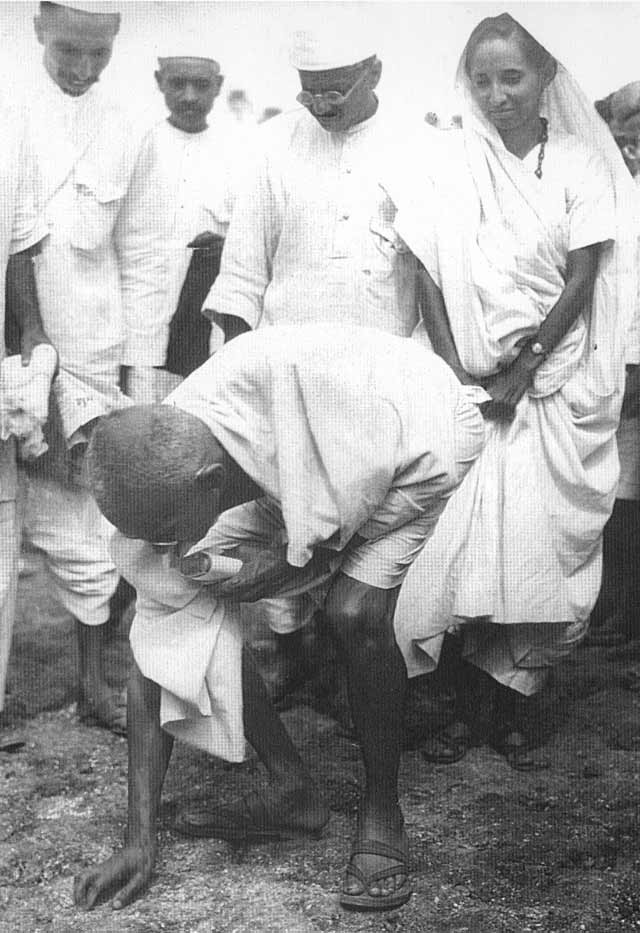Gandhi’s Salt: How a Fistful of Mud and Seawater Shook the British Empire
NONVIOLENCE, 11 Apr 2016
Rivera Sun, PeaceVoice – TRANSCEND Media Service
On April 6th, 1930 at 6:30 a.m. after morning prayers, Mohandas K. Gandhi raised a lump of salty mud and declared, “With this, I am shaking the foundations of the British Empire.”
Salt was an unexpected choice for the revolutionary nonviolent movement. Earlier that year, the Indian National Congress had boldly issued a declaration of self-rule, and the Working Committee of the Congress had asked Gandhi to choose a target for resisting British control. The initial reaction of the Working Committee to Gandhi’s choice of salt was incredulity. The committee thought the reaction of the average Indian would be that of laughter.
But, the salt law was particularly odious to the average Indian, as salt was a necessary ingredient of life in hot and humid India, and the British monopoly on production meant millions paid the British for what they once produced themselves. Furthermore, since the 1882 British Salt Law granted a monopoly on salt production to the British Empire, the proceeds from the salt represented a hefty 8.2 percent of total British tax revenue.
Lord Irwin, the Viceroy of India, apparently didn’t do the math on this particular scheme of Gandhi’s. When he caught wind of the Indians’ plans, he grumbled that he would not lose any sleep over salt. The joke however, was on him, as it is often quipped that while he did not lose any sleep over salt, he did lose India.
On March 12th, Gandhi set out from his ashram with 78 satyagrahis. The march traveled 390 kilometers through four districts and 48 villages, raising awareness and participation in the march and upcoming civil disobedience at each stop. Speeches were given, funds raised, new satyagrahis registered, and resignations of local officials who had decided to non-cooperate with the British were collected. Gandhi gave interviews and wrote articles along the way, using press coverage to further his cause. (The Young India, Gandhi’s journal for the Self-Rule Movement, was the world’s largest circulation newspaper at the time.)
On April 6th, Gandhi stood at the edge of the ocean, picked up a handful of salty mud. When 50,000 gathered Indians likewise followed suit, their mass act of civil disobedience of unjust laws commenced.
Wikipedia reports, “What had begun as a Salt Satyagraha quickly grew into a mass Satyagraha. British cloth and goods were boycotted. Unpopular forest laws were defied in the Maharashtra, Karnataka and Central Provinces. Gujarati peasants refused to pay tax, under threat of losing their crops and land. In Midnapore, Bengalis took part by refusing to pay the chowkidar tax. The British responded with more laws, including censorship of correspondence and declaring the Congress and its associate organizations illegal. None of those measures slowed the civil disobedience movement.”
At midnight on May 4th, the British arrested Gandhi. A few weeks later, the movement carried forward its plans to nonviolently seize the Dharsana Salt Works. They were brutally beaten, and the story of the violence was reported on by 1,350 newspapers throughout the world.
Civil disobedience continued throughout 1930, escalating and intensifying.
In early 1931, Gandhi was released from prison and Lord Irwin began formal negotiations and talks. Though the negotiations failed to achieve many of the Indians core demands, future Prime Minister Jawaharlal Nehru said,
“. . . the real importance, to my mind, lay in the effect they had on our own people . . . Non-cooperation dragged them out of the mire and gave them self-respect and self-reliance.”
The Salt Satyagraha is one of the most iconic campaigns in nonviolent history. A masterful blend of constructive action, mass civil disobedience, and acts of protest and persuasion, it holds powerful lessons to understand about movement-building, resistance, and nonviolence.
_______________________________________
Author/Activist Rivera Sun, syndicated by PeaceVoice, is the author of The Dandelion Insurrection and other books, and the Programs Coordinator for Campaign Nonviolence.
This article originally appeared on Transcend Media Service (TMS) on 11 Apr 2016.
Anticopyright: Editorials and articles originated on TMS may be freely reprinted, disseminated, translated and used as background material, provided an acknowledgement and link to the source, TMS: Gandhi’s Salt: How a Fistful of Mud and Seawater Shook the British Empire, is included. Thank you.
If you enjoyed this article, please donate to TMS to join the growing list of TMS Supporters.

This work is licensed under a CC BY-NC 4.0 License.
